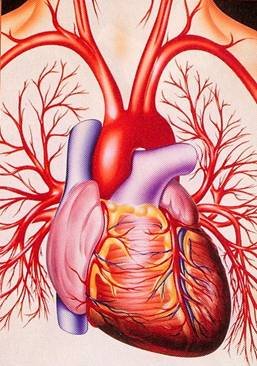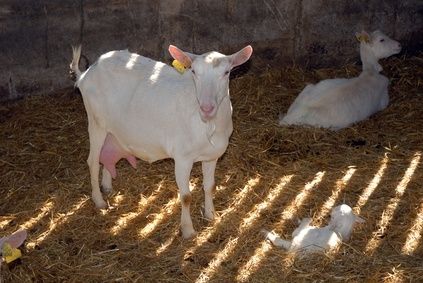
Diseases From Milk—
Heart Disease
Xanthine Oxidase-
A New Culprit?
WHAT CAUSES HEART AND ARTERY DISEASE?
Dairy milk is a rich source of xanthine oxidase, an enzyme occurring naturally in milk. Goat and sheep milk contains less xanthine oxidase than cow’s milk. boiling but not homogenization or pasteurization, will destroy zanthine oxidase. The natural function of xanthine oxidase is to control the last stages of purine metabolism with its end-product, uric acid, the waste product related to gout.
Folic acid is a xanthine oxidase inhibitor and prevent or arrests the progress of dietary atherosclerosis. There is a significant decline in angina and repeated heart attacks in persons treated with folic acid, supporting the idea that xanthine oxidase is active in the cause of artery disease. Medical Tribune, August 23, 1978
In heart and artery disease, xanthine oxidase may chemically produce the injury that initiates atheroscrotic lesions in the vessel walls by depleting the plasmalogen content of arterial and heart tissue. when this enzyme is biochemically unavailable, as in population groups as in France or India who did not homogenize their milk, but do boil the milk, or in societies where little or no milk is taken, coronary heart disease is extremely low. In one study of atherosclerotic persons, 73 of 94 subects were found to have antibodies to bovine milk xanthine oxidase.
MILKSHAKES AND TONSILLECTOMYA
There are highly significant correlations between heavy milkshake and milk consumption in early life, and the presence of abnormal blood fat patterns, low serum glucose levels, (hypoglycemia, which predicts a tendency toward diabetes) and the incidence of tonsillectomy at age ten or later. All these factors in the history also correlate with the presence of antibodies to bovine milk xanthine oxidase. It appears that the gastrointestinal tract can learn to take up bovine milk xanthine oxidase directly without digesting it. Perhaps the function of completely digesting milk is injured by over consumption of milk in early life and especially by the use of milk-sugar combinations such as milkshakes and sweetened cereals and milk.
Dr. Kurt A. Oster, a leading cardiologist, believes that xanthine oxidase in milk is more related to the development of atherosclerosis than are milk fats and that it is the process of homogenizing milk and breaking up its fat into the tiny particles for even distribution through the milk, which enables portions of milk to be absorbed directly into the blood stream from the gastrointestinal tract. Along with these finely divided particles of fat, the xanthine oxidase goes directly through the walls of the intestines and acts chemically to injure the artery walls and heart tissues as previously mentioned. American Heart Journal February, 1971
DISEASES CAUSED BY CONTAMINANTS
Female sex hormones and thyroid hormones are administered to cows to increase milk yield. Every year in this country, antibiotics worth 478 million dollars are added to animal feeds to increase milk yield. The antibiotics and hormones used in the feed turn up in both the milk and the meat from these animals. Antibiotic-resistant bacteria are developing as a result of repeated small exposures to the antibiotics and are being fed continually into the population from this source. Science News, May 27, 1972
Certain toxic substances are absorbed into the blood more easily when in the presence of particular foods that act as helpers. Lead bears such a relationship to milk, being absorbed more readily in the presence of milk. More lead can be absorbed by the animal if the feed contains swill (refuse food mixed with milk condemned by the inspectors). High lead levels then appear in the tissues of animals fed contaminated feed. Several years ago, there was a widely publicized case in the newspapers of a man who fed contaminated feed to his hogs. His wife and two children died from the lead-contaminated meat, and another child was permanently brain-damaged from the toxic effects on the nerves.
Cadmium is known to be associated with deaths from kidney and artery disease. Diet and drinking water are the chief sources of human cadmium intake. Milk cadmium is used as a crude index of the total dietary cadmium. It has been shown that if milk consumed in the spring has a high cadmium level, there will be a high positive correlation with deaths from heart and blood vessel disease later that year. Medical Tribune, June, 1972
Unwashed vegetation containing dangerous radionuclides, eaten by cattle and excreted in the milk, is found to be an important cause of man’s dietary intake of environmental radio activity. Fresh milk contains several of the biologically important radionuclides. Strontium 89, strontium 90, iodine 131, barium 140, and cesium 137 are sources of environmental radio-activity, all of which occur in milk. Strontium 90, closely resembling calcium in its chemical behavior, follows the food chain in the same way that calcium does from the soil, into grass, into milk, and finally into children, being lodged in the growing bones of children. Embedded in bone it exposes nearby cells to beta radiation, increasing the lifetime risk of cancer.
GOATS MILK NOT THE ANSWER
The levels of strontium 90 in the milk produced nearby, and in the diet of those living near nuclear power plants were greater when checked in 1976 than in areas far removed from nuclear power plants. Hospital Practice January 1978 Nor is taking goats milk the answer, as goat’s milk was found to be higher in strontium 90 than cow’s milk.
Scientists investigating the case of a baby born with sever bone deformities of his arms and legs had learned that his mother had used goat’s milk during pregnancy. The goat had given birth to kids with similar deformities, and a dog, also given goat’s milk had given birth to deformed pups. The researchers felt that a toxic forage plant eaten by the goat produced the deformities. Science News December 26, 1981.

Pesticides such as DDT, appear in milk samples, as do polychlorinated biphenyls (PCBs). The amounts found exceed the Food and Drug Administration maximums. PCBs are concentrated in milk fat, and their behavior is quite similar to chlorinated hydrocarbon residues. The dangers from milk were recently underscored because of the contamination of milk by PBBs (polybrominated biphenyls). Thousands of people in Michigan in 1973 were exposed to these substances before the contamination was discovered. Science News August 13, 1977
Female sex hormones and other hormone substances are often administered to cattle. In cows, the volume of milk produced is increased by 30 percent (with a corresponding increase in milk solids by giving thyroxin and thyroglobulin.
When cattle eat bracken fern, toxic substances from the fern appear in the milk. Such milk has been found to contain certain fractions demonstrated to mutagenic activity in cells, increasing the risk of deformities in babies and cancer in all ages. Aflatoxin, the potent cancer-producing agent produced by fungi, has been discovered in significant quantities in milk. It gets into milk by the growth of fungi in the feed of the animals. Food and Cosmetic Toxicology 1968
GOITERS IN TASMANIA
A goitrogenic substance was found in milk as early as 1957. It is believed by some that the calcium of milk may act as a goitrogen. It has also been suggested that since cattle consume large quantities of the plant genus Brassica which includes cabbages, mustards, rapes, kale and turnips, in their forage material, and are fed whole peanuts, that goitrogens become concentrated in milk from this source.
In Tasmania an epidemic of goiters occurred in school children. It was observed that children who drank milk developed the goiters, and those who did not drink milk had no goiters. On investigation, it was discovered that the local cattle had been fed fodder made from cabbages and related greens. These greens contain a goitrogenic agent, thiourea. The thiorea is excreted in the milk. It was this substance, which gave the school children goiter.
A. & C. Thrash